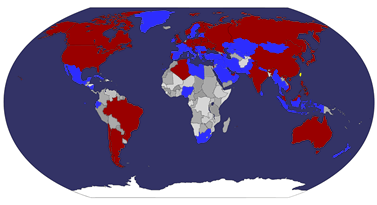Le 20ème anniversaire de l'ouverture de la frontière entre la Hongrie et l'Autriche/
20 Jahre Grenzöffnung Ungarn-Österreich/
A magyar-osztrák határnyitás 20. évfordulója



 The present joint issue, “20th anniversary of the opening of the border between Hungary and Austria”, is the commemoration by the post offices of Hungary (Magyar Posta), Germany and Austria of one of the most important political events of recent history. The fall of the Iron Curtain in 1989 after decades of separation led to permanent changes in and for Europe, not only from a political point of view but also in terms of the economy and society.
The present joint issue, “20th anniversary of the opening of the border between Hungary and Austria”, is the commemoration by the post offices of Hungary (Magyar Posta), Germany and Austria of one of the most important political events of recent history. The fall of the Iron Curtain in 1989 after decades of separation led to permanent changes in and for Europe, not only from a political point of view but also in terms of the economy and society.By opening its borders to the west precisely 20 years ago, Hungary made a major contribution to a new and united Europe. This historic revolution was the result of months of a process of change in which the previous political system of the East, characterised by rigid Soviet communism, was broken up. The region around Vienna, as so often in history, played a major role as the gate to a new Europe.
After the Hungarian border troops had begun as early as April 1989 to demolish the Iron Curtain at four points, initially as a trial and under strict secrecy, events followed thick and fast throughout Europe. On 27 June, near Sopron, a highly symbolic moment occurred when the foreign ministers of Hungary and Austria, Gyula Horn and Alois Mock, jointly cut through the barbed wire. In view of the whole world, the Iron Curtain fell, and the end of a divided Europe came one historic step closer.
There is no doubt that the “Pan European picnic” (an intercultural dialogue forum) had a huge inner-political influence on the Németh government in Budapest. Initially hesitating to open the border entirely to the citizens of East Germany, a few days later it nevertheless resolved to do so, and at a meeting between the Hungarian Prime Minister and the German chancellor Helmut Kohl on August 25, 1989, it was agreed that Hungary neither could nor would hold back the refugees from East Germany any longer. (One day before, the Hungarian government had approved the exit to West Germany of more than 100 GDR citizens who had taken refuge in the West German embassy in Budapest.) On September 10, 1989, Foreign Minister Gyula Horn finally announced that the border would be opened at midnight. East German tourists were thus free to leave for Germany via Austria. “This removed the first brick in the Berlin Wall,” is how Helmut Kohl later described the importance of the opening of the Hungarian border.
A few weeks later, President Mátyas Szürös proclaimed the new democratic Republic of Hungary. The Berlin Wall fell on 9 November 1989.
Die Briefmarke erscheint als motivgleiche Gemeinschaftsausgabe mit Ungarn und Österreich und erinnert an die Öffnung der ungarisch-österreichischen Grenze, die ein entscheidender Impuls für die revolutionären Vorgänge im Herbst 1989 war. Angefangen hatte es 1989 pragmatisch: Da den Ungarn die Renovierung des Signalzauns zu Österreich zu teuer war, begannen sie am 2. Mai 1989 mit dessen Abbau. In einem symbolischen Akt zerschnitten der ungarische Außenminister Gyula Horn und sein österreichischer Amtskollege Alois Mock am 27. Juni 1989 ein Stück Stacheldraht in der Nähe der Grenzstadt Sopron. Nun hofften viele DDR-Bürger, die in Ungarn Urlaub machten, in den Westen flüchten zu können. Die DDR aber bestand gegenüber Ungarn auf Regelungen, die die Ausreise untersagten und die Auslieferung von Flüchtlingen verlangten. Das diplomatische Problem zwischen der DDR, Ungarn und der Bundesrepublik Deutschland entwickelte sich bald zur Flüchtlingskrise, in der hunderte Menschen die grüne Grenze nach Österreich überquerten. Am 11. September 1989 öffnete Ungarn dann die Grenze zu Österreich. Die Flüchtlingskrise wurde für die DDR im Oktober zur Systemkrise. Am 3. November 1989 schließlich gestattete die DDR ihren Bürgern die direkte Ausreise aus der CSSR in die Bundesrepublik Deutschland. Sechs Tage später fiel die Mauer...
1989. május 2-án megkezdődött a magyar-osztrák határon lévő, az illegális határátlépések megakadályozására épített műszaki zár lebontása. Augusztus 19-én több ezren vettek részt Sopron térségében, a határ közelében rendezett páneurópai pikniken, ahol a határok nélküli Európa megteremtését sürgették. A magyar kormány 1989. szeptember 10-i bejelentését követően, 1989. szeptember 11-től a Magyarországon tartózkodó és hazatérni nem kívánó keletnémet állampolgárok kiutazhattak olyan más országokba, amelyek hajlandóak számukra a be- vagy átutazást engedélyezni.
A határnyitásként ismert, történelemformáló esemény 20. évfordulóján Magyarország, Ausztria és Németország közös bélyeget bocsát forgalomba. A kibocsátás érdekessége, hogy a bélyeg mindhárom országban Benedek Imre, magyar bélyegtervező grafikusművész tervei alapján valósult meg. A kék színű háttérben a bélyegek főmotívuma az eseményre utaló jubileumi szám, amelynek grafikai képét – a sorsfordító határnyitásra utaló konkrét üzenettel kiegészítve – a tervezőművész a három ország nemzeti zászlóinak színeiből komponálta.
Az alkalmi boríték grafikáján térképrészlet és a három ország nemzeti zászlói láthatók, az alkalmi bélyegző a határátkelést idéző stilizált rajz. A három ország bélyegének együttes bemutatása céljával reprezentatív kivitelezésű emléklap is készült, melyen alkalmi bélyegzéssel szerepelnek az újdonságok. Az emléklap előlapját – az alkalmi boríték grafikájához illeszkedve – térképrészlet és zászlók díszítik.








.jpg)
























 taiwan
taiwan  cover or postcard
cover or postcard  FDC
FDC 






























































































No comments:
Post a Comment